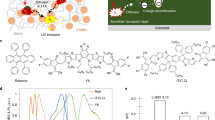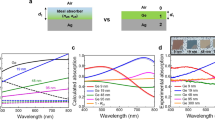Abstract
In materials showing reverse saturable absorption (RSA), the optical absorbance increases as the power of the light incident on them increases. To date, RSA has only been observed when very intense light sources, such as short-pulse lasers, are used. Here, we show that hydroxyl steroidal matrices embedding properly designed aromatic molecules as acceptors and transition-metal complexes as donors exhibit high RSA on exposure to weak incoherent light at room temperature and in air. Accumulation by photosensitization of long-lived room-temperature triplet excitons in acceptors with a large triplet–triplet absorption coefficient allows a nonlinear increase in absorbance also under low-power irradiation conditions. As a consequence, continuous exposure to weak light significantly decreases the transmittance of thin films fabricated with these compounds. These optical limiting properties may be used to protect eyes and light sensors from exposure to intense radiation generated by incoherent sources and for other light-absorption applications that have not been realized with conventional RSA materials.
This is a preview of subscription content, access via your institution
Access options
Subscribe to this journal
Receive 12 print issues and online access
$259.00 per year
only $21.58 per issue
Buy this article
- Purchase on Springer Link
- Instant access to full article PDF
Prices may be subject to local taxes which are calculated during checkout





Similar content being viewed by others
References
Nalwa, H. S. & Miyata, S. Nonlinear Optics of Organic Molecules and Polymers (CRC Press, 1997).
Mansour, K., Soileau, M. J. & Van Stryland, E. W. Nonlinear optical properties of carbon-black suspension (ink). J. Opt. Soc. Am. B 9, 1100–1109 (1992).
Nashold, K. M. & Walter, D. P. Investigation of optical limiting mechanism in carbon particle suspensions and fullerene solutions. J. Opt. Soc. Am. B 12, 1228–1237 (1995).
Tutt, L. W. & Kost, A. Optical limiting performance of C60 and C70 solutions. Nature 356, 225–226 (1992).
Chi, S-H. et al. Conjugated polymer-fullerene blend with strong optical limiting in the near-infrared. Opt. Express 17, 22062–22072 (2009).
Perry, J. W. et al. Organic optical limiter with a strong nonlinear absorptive response. Science 273, 1533–1536 (1996).
Perry, J. W. et al. Enhanced reversible saturable absorption and optical limiting in heavy-atom-substituted phthalocyanines. Opt. Lett. 19, 625–627 (1994).
De la Torre, G., Vazquez, P., Agullo-Lopez, F. & Torres, T. Role of structural factors in the nonlinear optical properties of phthalocyanines and related compounds. Chem. Rev. 104, 3723–3750 (2004).
Tang, B. Z. & Xu, H. Preparation, alignment, and optical properties of soluble poly(phenylacetylene)-wrapped carbon nanotubes. Macromolecules 32, 2569–2576 (1999).
Chen, P. et al. Electronic structure and optical limiting behavior of carbon nanotubes. Phys. Rev. Lett. 82, 2548–2551 (1999).
Vivien, L. et al. Single-wall carbon nanotubes for optical limiting. Chem. Phys. Lett. 307, 317–319 (1999).
Riggs, J. E., Walker, D. B., Carroll, D. L. & Sun, Y. P. Optical limiting properties of suspended and solubilized carbon nanotubes. J. Phys. Chem. B 104, 7071–7076 (2000).
Sun, X., Yu, R. Q., Xu, G. Q., Hor, T. S. A. & Jia, W. Broadband optical limiting with multiwalled carbon nanotubes. Appl. Phys. Lett. 73, 3632–3634 (1998).
McEwan, K. et al. Synthesis, characterization, and nonlinear optical study of metalloporphyrins. Adv. Funct. Mater. 13, 863–867 (2003).
Senge, M. O. et al. Nonlinear optical properties of porphyrins. Adv. Mater. 19, 2737–2774 (2007).
Hales, J. M., Cozzuol, M., Screen, T. E. O., Anderson, H. L. & Perry, J. W. Metalloporphyrin polymer with temporally agile, broadband nonlinear absorption for optical limiting in the near infrared. Opt. Express 17, 18478–18488 (2009).
Vijaya, R., Murti, Y. V. G. S., Vijayaraj, T. A. & Sundararajan, G. Optical nonlinearities in substituted conjugated polymers. Opt. Quant. Electron. 25, 723–731 (1993).
Zhou, G-J., Wong, W-Y., Dongmei, C. & Cheng, Y. Large optical-limiting response in some solution-processable polyplatinaynes. Chem. Mater. 17, 5209–5217 (2005).
Francois, L. et al. Optical limitation induced by gold clusters. Size effect. J. Phys. Chem. B 104, 6133–6137 (2000).
Sun, Y. P., Riggs, J. E., Rollins, H. W. & Guduru, R. Strong optical limiting of silver-containing nanocrystalline particles in stable suspensions. J. Phys. Chem. B 103, 77–82 (1999).
Jia, W. F., Douglas, E. P., Guo, F. G. & Sun, W. F. Optical limiting of semiconductor nanoparticles for nanosecond laser pulses. Appl. Phys. Lett. 85, 6326–6328 (2004).
Venkatram, N., Rao, D. N. & Akundi, M. A. Nonlinear absorption, scattering and optical limiting studies of CdS nanoparticles. Opt. Express 13, 867–872 (2005).
Pan, H., Chen, W. Z., Feng, Y. P., Ji, W. & Lin, J. Y. Optical limiting properties of metal nanowires. Appl. Phys. Lett. 88, 223106 (2006).
Zhou, G-J., Wong, W-Y., Lin, Z. & Ye, C. White metallopolyynes for optical limiting/transparency trade-off optimization. Angew. Chem. Int. Ed. 45, 6189–6193 (2006).
Zhou, G-J., Wong, W-Y., Poon,, Ye, C. & Lin, Z. Optical power limiters based on colorless di-, oligo-, and polymetallaynes: Highly transparent materials for eye protection devices. Adv. Funct. Mater. 17, 963–975 (2007).
Zhou, G-J., Wong, W-Y., Poon, S-Y., Ye, C. & Lin, Z. Symmetric versus unsymmetric platinum (II) bis(aryleneethynylene)s with distinct electronic structures for optical power limiting/optical transparency trade-off optimization. Adv. Funct. Mater. 19, 531–544 (2009).
Zhou, G-J. & Wong, W-Y. Organometallic acetylides of PtII, AuI and HgII as new generation optical power limiting materials. Chem. Soc. Rev. 40, 2541–2566 (2011).
Xu, Y. et al. A Graphene hydrid material covalently functionalized with porphyrin: Synthesis and optical limiting property. Adv. Mater. 21, 1275–1279 (2009).
Wang, J., Hernandez, Y., Lotya, M., Coleman, J. N. & Blau, W. J. Broad nonlinear optical response of graphene dispersions. Adv. Mater. 21, 2430–2435 (2009).
Zhao, B., Cao, B., Zhou, D., Li, D. & Zhao, W. Nonlinear optical transmission of nanographene and its composites. J. Phys. Chem. C 114, 12517–12523 (2010).
Feng, M., Zhan, H. & Chen, Y. Nonlinear optical and optical limiting properties of graphene families. Appl. Phys. Lett. 96, 033107 (2010).
Lim, G-K. et al. Giant broadband nonlinear optical absorption response in dispersed graphene single sheets. Nature Photon. 5, 554–560 (2011).
Xu, X. et al. Water-soluble graphene sheets with large optical limiting response via non-covalent functionalization with polyacetylenes. J. Mater. Chem. 22, 22624–22630 (2012).
Hirata, S. et al. Efficient persistent room temperature phosphorescence in organic amorphous materials under ambient conditions. Adv. Funct. Mater. 23, 3386–3397 (2013).
Hirata, S. et al. Reversible thermal recording media using time-dependent persistent room temperature phosphorescence. Adv. Opt. Mater. 1, 483–488 (2013).
Endo, A. et al. Measurement of phosphorescence efficiency of Ir(III) phenylpyridine derivatives in solution and solid-state films. Chem. Phys. Lett. 460, 155–157 (2008).
Bensasson, R. & Land, J. E. Triplet–triplet extinction coefficients via energy transfer. Trans. Faraday Soc. 67, 1904–1915 (1971).
Baldo, M. A., Adachi, C. & Forrest, S. R. Transient analysis of organic electrophosphorescence. II. Transient analysis of triplet–triplet annihilation. Phys. Rev. B 62, 10967–10977 (2000).
Tanaka, I. & Tokito, S. Phosphorescent-sensitized triplet–triplet annihilation in tris(8-hydroxyquinoline) aluminum. J. Appl. Phys. 97, 113532 (2005).
Kawamura, Y., Brooks, J., Brown, J. J., Sasabe, H. & Adachi, C. Intermolecular interaction and a concentration-quenching mechanism of phosphorescent Ir(III) complexes in a solid film. Phys. Rev. Lett. 96, 017404 (2006).
Burrows, H. D., Fernandes, M., Melo, J. S., Monkman, A. P. & Navaratnam, S. Characterization of the triplet state of tris(8-hydroxyquinoline) aluminium(iii) in benzene solution. J. Am. Chem. Soc. 125, 15310–15311 (2003).
Acknowledgements
This work was supported by a Grant-in-Aid for Young Scientists (B) (22750132), a Grant-in-Aid for Young Scientists (A) (26708010), a Grant-in-aid from the Funding Program for World-Leading Innovative R&D on Science and Technology (FIRST), a Japan Association for Chemical Innovation grant, a Japan Bioindustry Association grant, a Tokyo Tech Engineering Grant for New Assistant Professors, the Cosmetology Research Foundation, a grant for Basic Science Research Projects from the Sumitomo Foundation, and the Adaptable and Seamless Technology Transfer Program through Target-driven R&D (AS231Z01236B).
Author information
Authors and Affiliations
Contributions
S.H. proposed the concept of a reverse saturable absorber using accumulation of long-lived room-temperature triplet excitons and designed the materials. S.H. measured device characteristics and collected data. K.T. helped with absorption measurements and T.Y. helped with transient absorption measurements. S.H. performed analyses. S.H., C.A. and M.V. wrote the manuscript. All authors discussed the progress of research and reviewed the manuscript.
Corresponding authors
Ethics declarations
Competing interests
The authors declare no competing financial interests.
Supplementary information
Supplementary Information
Supplementary Information (PDF 4720 kb)
Rights and permissions
About this article
Cite this article
Hirata, S., Totani, K., Yamashita, T. et al. Large reverse saturable absorption under weak continuous incoherent light. Nature Mater 13, 938–946 (2014). https://doi.org/10.1038/nmat4081
Received:
Accepted:
Published:
Issue Date:
DOI: https://doi.org/10.1038/nmat4081
This article is cited by
-
Photo-thermo-induced room-temperature phosphorescence through solid-state molecular motion
Nature Communications (2022)
-
Room-temperature phosphorescence from organic aggregates
Nature Reviews Materials (2020)
-
Biocompatible metal-free organic phosphorescent nanoparticles for efficiently multidrug-resistant bacteria eradication
Science China Materials (2020)
-
Boosting the efficiency of organic persistent room-temperature phosphorescence by intramolecular triplet-triplet energy transfer
Nature Communications (2019)
-
Reversible control of triplet dynamics in metal-organic framework-entrapped organic emitters via external gases
Communications Chemistry (2018)



